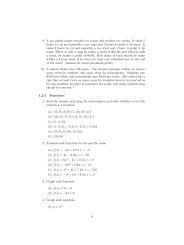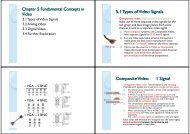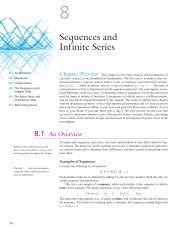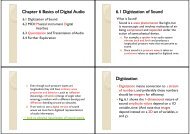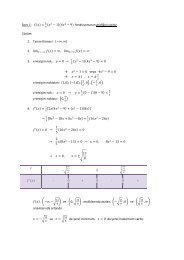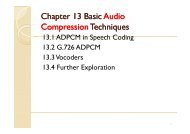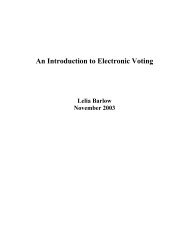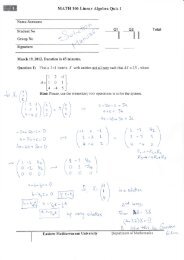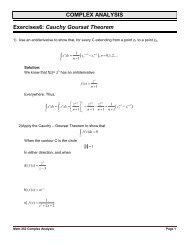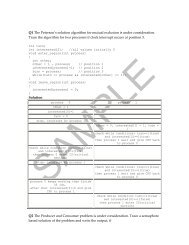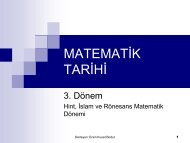Chapter 1: Operating System Concepts
Chapter 1: Operating System Concepts
Chapter 1: Operating System Concepts
Create successful ePaper yourself
Turn your PDF publications into a flip-book with our unique Google optimized e-Paper software.
<strong>Chapter</strong> 1: <strong>Operating</strong> <strong>System</strong> <strong>Concepts</strong><br />
1. What are the two main functions of an operating system?<br />
An operating system must provide the users with an extended (i.e., virtual) machine,<br />
and it must manage the I/O devices and other system resources.<br />
2. What is multiprogramming?<br />
Multiprogramming is the rapid switching of the CPU between multiple processes in<br />
memory. It is commonly used to keep the CPU busy while one or more processes are<br />
doing I/O.<br />
3. What is the difference between timesharing and multiprogramming systems?<br />
In a timesharing system, multiple users can access and perform computations on a<br />
computing system simultaneously using their own terminals. Multiprogramming systems<br />
allow a user to run multiple programs simultaneously. All timesharing systems<br />
are multiprogramming systems but not all multiprogramming systems are timesharing<br />
systems since a multiprogramming system may run on a PC with only one user.<br />
4. What is spooling? Do you think that advanced personal computers will have spooling<br />
as a standard feature in the future?<br />
Input spooling is the technique of reading in jobs, for example, from cards, onto the<br />
disk, so that when the currently executing processes are finished, there will be work<br />
waiting for the CPU. Output spooling consists of first copying printable files to disk<br />
before printing them, rather than printing directly as the output is generated. Input<br />
spooling on a personal computer is not very likely, but output spooling is.<br />
5. There are several design goals in building an operating system, for example, resource<br />
utilization, timeliness, robustness, etc. Give an example of two design goals that may<br />
contradict one another.<br />
Consider the goals of fairness and real time. Fairness requires that each process be allocated<br />
its resources in a fair way, with no process getting more than its fair share. On<br />
the other hand, real time requires that resources be allocated based on the times when<br />
different process must complete their execution. A high priority real-time process may<br />
get a disproportionate share of the resources.<br />
6. What is the difference between kernel and user mode? Explain how having two distinct<br />
modes aids in designing an operating system.<br />
Most modern CPUs provide two modes of execution: kernel mode and user mode. The<br />
CPU can execute every instruction in its instruction set and use every feature of the<br />
hardware when executing in kernel mode. However, it can execute only a subset of instructions<br />
and use only subset of features when executing in the user mode. Having<br />
two modes allows designers to run user programs in user mode and thus deny them access<br />
to critical instructions.<br />
7. Which of the following instructions should be allowed only in kernel mode?<br />
(a) Disable all interrupts.<br />
(b) Read the time-of-day clock.<br />
(c) Set the time-of-day clock.<br />
(d) Change the memory map.<br />
Choices (a), (c), and (d) should be restricted to kernel mode.
8. List some differences between personal computer operating systems and mainframe<br />
operating systems.<br />
Personal computer systems are always interactive, often with only a single user. Mainframe<br />
systems nearly always emphasize batch or timesharing with many users. Protection<br />
is much more of an issue on mainframe systems, as is efficient use of all resources.<br />
9. What is the purpose of a system call in an operating system? Give examples of system calls.<br />
A system call allows a user process to access and execute operating system functions<br />
inside the kernel. User programs use system calls to invoke operating system services.<br />
fork: a (UNIX) system call used for creating child processes.<br />
open: a system call used for initializing access to a file.<br />
kill: a (UNIX) system call used for terminating a process.<br />
10. In order to use a computer system, you have to give commands to its operating system. Name two<br />
types of user interfaces used to issue commands to an operating system and explain how each work.<br />
Your answer<br />
<strong>Chapter</strong> 2: Processes<br />
1. A computer system has enough room to hold four programs in its main memory. These programs are<br />
idle waiting for I/O half the time. What fraction of the CPU time is wasted?<br />
The chance that all four processes are idle is 1/16, so the CPU idle time is<br />
1/16.<br />
2. A computer has 2 GB of RAM of which the operating system occupies 256 MB. The processes are all<br />
128 MB (for simplicity) and have the same characteristics. If the goal is 99% CPU utilization, what is<br />
the maximum I/O wait that can be tolerated?<br />
There is enough room for 14 processes in memory. If a process has an I/O of<br />
p, then the probability that they are all waiting for I/O is p 14 . By equating<br />
this to 0.01, we get the equation p 14 = 0.01. Solving this, we get p = 0.72, so<br />
we can tolerate processes with up to 72% I/O wait.<br />
3. What is a race condition?<br />
A race condition is a situation in which two (or more) processes are about to<br />
perform some action involving some shared data. Depending on the exact timing, one or the other goes<br />
first. If one of the processes goes first, everything works, but if another one goes first, a fatal error occurs.<br />
4. A computer has enough room to hold three processes in its main memory. First process spends 40%<br />
of its time for CPU utilization This measure is 50% and 60% for second and third processes,<br />
respectively.<br />
a) Calculate overall wasted time (I/O wait time). Your answer<br />
b) What is the CPU utilization in this case? Your answer<br />
5. Calculate overall CPU utilization if the three processes located in memory spend 20%, 40%, and<br />
60% of their time in memory for CPU utilization, respectively.<br />
Your answer<br />
6. What is a process? What does a process consist of?<br />
A process is basically a program in execution. It consists of the executable program, the program’s data and<br />
stack, program counter, stack pointer, and other registers and all the other information needed to run the<br />
program.
7. Name the three process states. Explain all possible transitions among these states.<br />
Your answer<br />
8. List four conditions that are necessary for multiple processes to cooperate correctly and efficiently<br />
using shared data.<br />
1. No two processes may be simultaneously inside their critical sections.<br />
2. No assumptions may be made about speeds or the number of CPUs.<br />
3. No process running outside its critical section may block other processes.<br />
4. No process should have to wait forever to enter its critical section.



